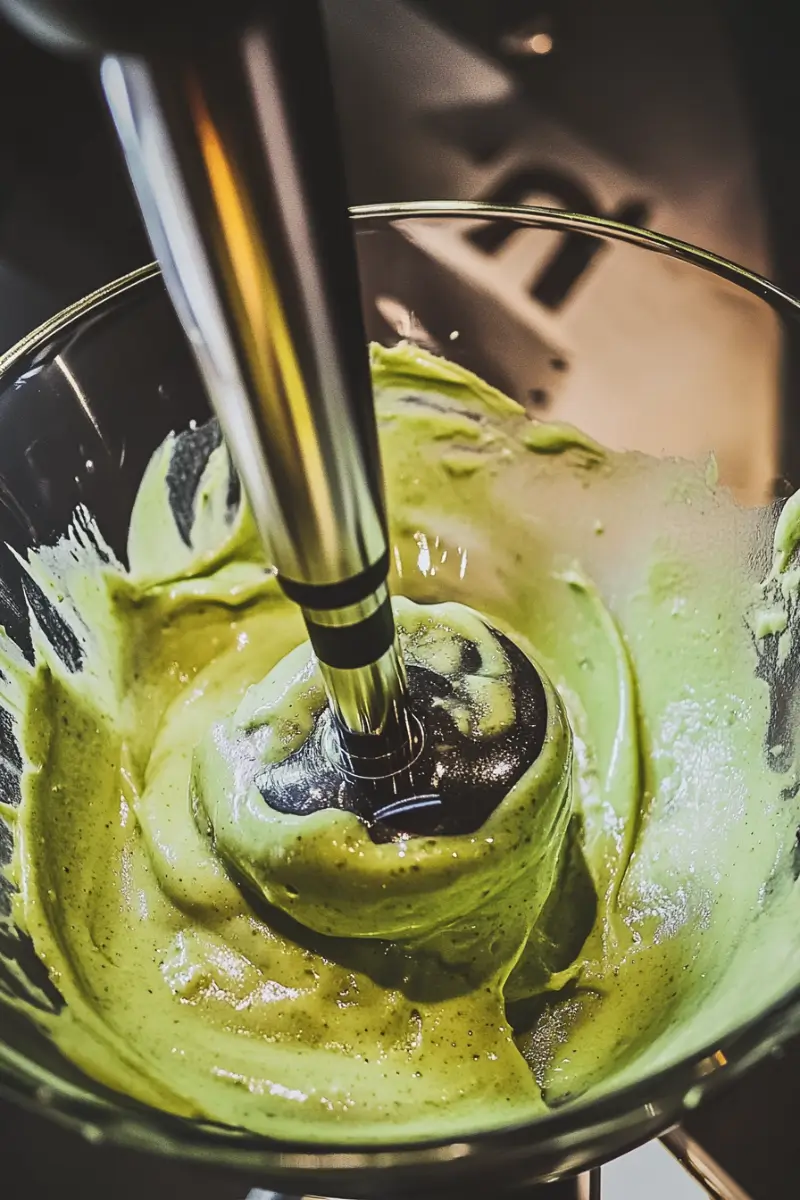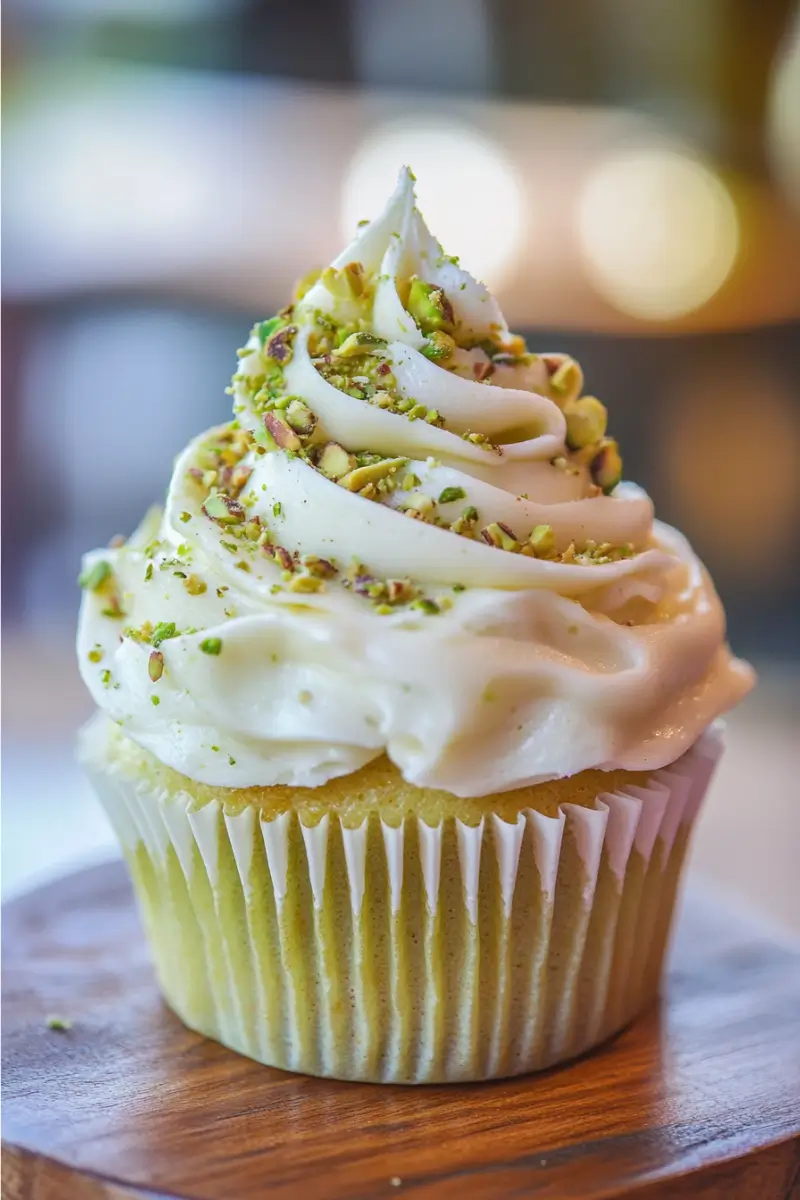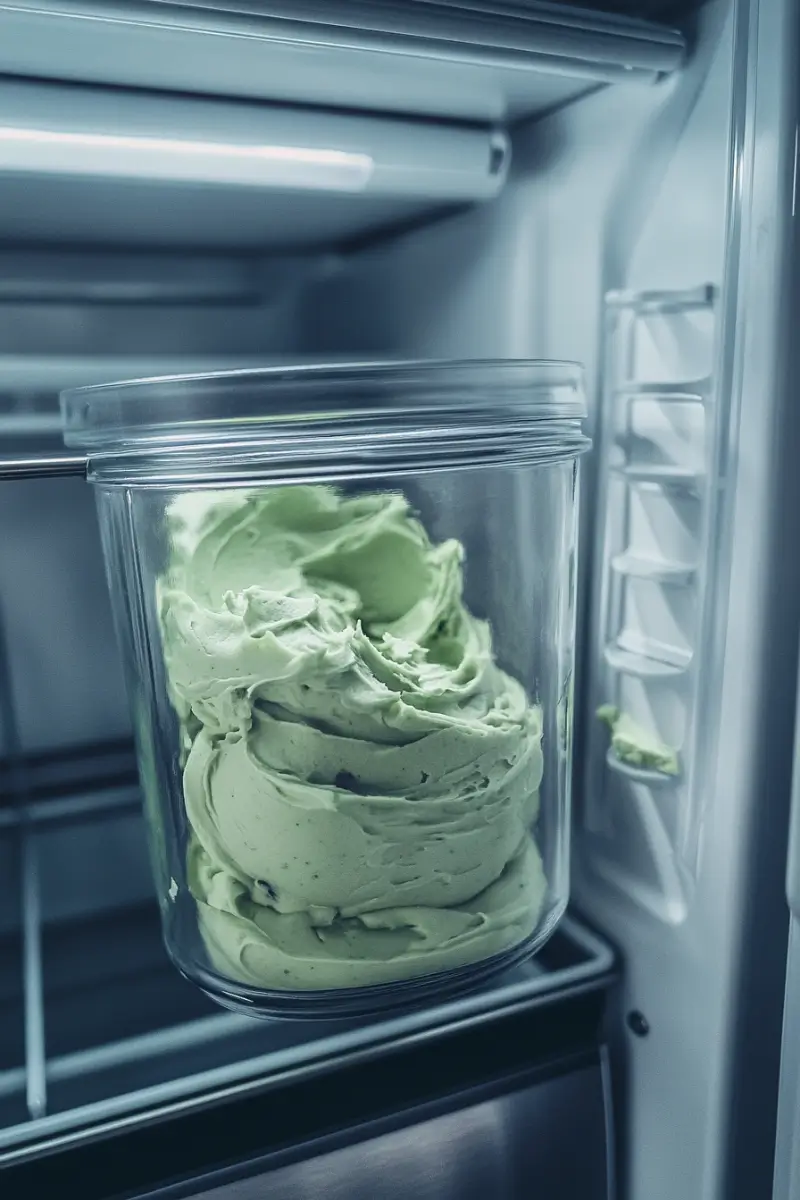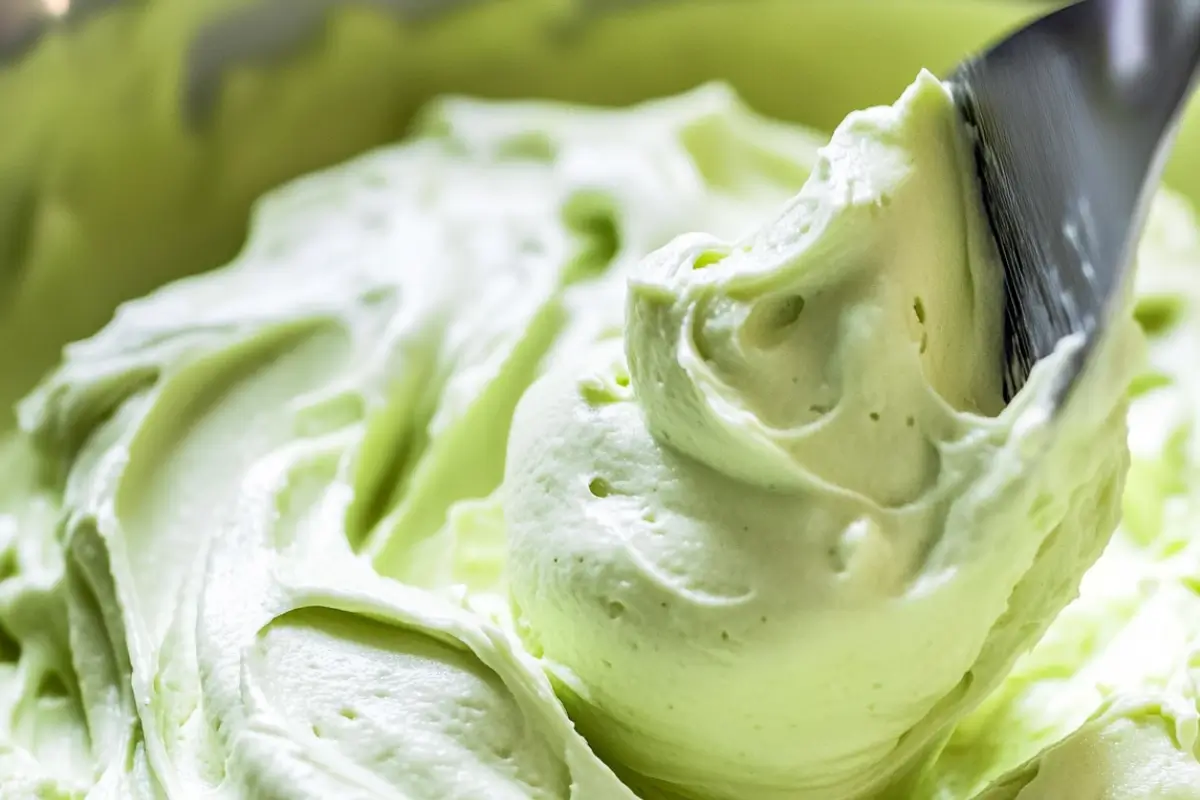Pistachio buttercream frosting is a rich, nutty, and velvety frosting that adds a unique twist to traditional buttercream. Whether you’re decorating cupcakes, filling layer cakes, or simply looking for a new way to enhance your baked goods, this frosting is an excellent choice. Its delicate balance of sweetness and nuttiness makes it a favorite among professional bakers and home cooks alike.
In this article, we’ll explore everything you need to know about pistachio buttercream frosting, from its ingredients and preparation to pairing suggestions and expert tips. You’ll learn how to make the perfect batch, avoid common mistakes, and discover what makes this frosting stand out.
Why Choose Pistachio Buttercream Frosting?
- Unique Flavor – Combines the buttery richness of traditional buttercream with the earthy, slightly sweet taste of pistachios.
- Smooth & Creamy Texture – When made correctly, it has a light, fluffy consistency that spreads beautifully on cakes and cupcakes.
- Versatile Usage – Pairs well with a variety of desserts, including chocolate, vanilla, and fruit-based cakes.
- Natural Green Tint – Unlike artificially colored frostings, pistachios give a subtle, natural green hue, making it visually appealing.
What You’ll Learn in This Guide
- What makes pistachio buttercream different from regular buttercream?
- How to make it step by step, including tips for perfect consistency.
- Best flavor pairings for pistachio buttercream frosting.
- How to store and preserve it for future use.
- Answers to common questions about buttercream, including why it’s banned in some states.
If you love experimenting with new frosting flavors or want to impress guests with a gourmet-style dessert, pistachio buttercream frosting is a must-try. Let’s dive in!
What is Pistachio Buttercream Frosting?
Defining Pistachio Buttercream Frosting
Pistachio buttercream frosting is a luxurious, nutty variation of traditional buttercream, made by incorporating finely ground pistachios or pistachio paste into a classic buttercream base. The result is a smooth, creamy frosting with a delicate balance of sweetness and rich pistachio flavor. Unlike artificially flavored frostings, pistachio buttercream delivers a natural, earthy taste with a hint of buttery richness.
Key Ingredients of Pistachio Buttercream Frosting
A classic pistachio buttercream typically includes:
- Unsalted butter – The foundation of any buttercream, providing a rich, creamy texture.
- Powdered sugar – Sweetens the frosting while maintaining smoothness.
- Pistachio paste or ground pistachios – Adds authentic nutty flavor and a natural green hue.
- Heavy cream or milk – Helps achieve the perfect consistency.
- Vanilla extract – Enhances the sweetness and depth of flavor.
- Salt – Balances out the sweetness for a well-rounded taste.
Buttercream vs. Frosting: What’s the Difference?
Many people use the terms buttercream and frosting interchangeably, but they have distinct differences:
- Base Ingredient: Buttercream is made primarily with butter or shortening, while frosting often uses powdered sugar, cream cheese, or whipped cream as its base.
- Texture: Buttercream has a creamy, smooth, and rich consistency, whereas frosting tends to be lighter, fluffier, or sometimes stiff, depending on the ingredients used.
- Taste: Buttercream is known for its buttery and sweet flavor, while frosting can vary from light and sweet to tangy, depending on whether it contains ingredients like cream cheese.
- Best Uses: Buttercream is ideal for piping, filling, and decorating cakes and cupcakes, whereas frosting is better suited for covering cakes, glazing pastries, and creating a fluffy topping.
Since pistachio buttercream frosting is a butter-based frosting, it falls under the buttercream category, making it ideal for piping intricate designs, filling layer cakes, or spreading on cupcakes.
Variations of Pistachio Buttercream
Pistachio buttercream can be made in different styles, depending on preference:
- American Pistachio Buttercream – The simplest version, using butter, powdered sugar, and pistachio paste.
- Swiss Meringue Pistachio Buttercream – Uses egg whites and sugar, resulting in a silky, less sweet texture.
- Italian Meringue Pistachio Buttercream – A more stable version, incorporating a hot sugar syrup into egg whites before adding butter and pistachios.
- French Pistachio Buttercream – Made with egg yolks for an ultra-rich, custard-like consistency.
Each type of pistachio buttercream varies in sweetness, stability, and texture, making them suitable for different types of desserts.
Discover great ideas like our best cake recipes that pair perfectly with pistachio buttercream frosting!
How to Make Pistachio Buttercream Frosting (Step-by-Step Guide)

Ingredients You’ll Need
To make a smooth and flavorful pistachio buttercream frosting, you’ll need the following ingredients:
- Unsalted butter (room temperature) – 1 cup (2 sticks): Forms the rich, creamy base of the frosting.
- Powdered sugar – 3 to 4 cups: Sweetens the frosting and helps stabilize its texture.
- Pistachio paste (or finely ground pistachios) – ½ cup: Adds an authentic pistachio flavor and a natural green hue.
- Heavy cream or milk – 2 to 3 tablespoons: Helps adjust the consistency, making the frosting smoother.
- Vanilla extract – 1 teaspoon: Enhances the overall flavor, adding warmth and depth.
- Salt – ¼ teaspoon: Balances the sweetness and enhances the nutty flavor of the pistachios.

Step-by-Step Instructions
Step 1: Cream the Butter
- In a large mixing bowl, beat the room-temperature butter using a hand mixer or stand mixer for 2-3 minutes on medium speed.
- Continue beating until the butter turns light, fluffy, and pale in color.
Step 2: Add the Pistachio Paste
- Gradually mix in the pistachio paste (or finely ground pistachios).
- Blend until the pistachio is fully incorporated, and the mixture becomes smooth and creamy.
Step 3: Incorporate the Powdered Sugar
- Slowly add powdered sugar, one cup at a time, mixing on low speed to prevent a sugar cloud.
- Increase the speed to medium and beat until well combined.
Step 4: Adjust Consistency with Cream
- Add 1 tablespoon of heavy cream or milk at a time until you reach the desired consistency.
- If the frosting is too thick, add a little more liquid.
- If it’s too thin, add extra powdered sugar.
Step 5: Enhance the Flavor
- Stir in the vanilla extract and a pinch of salt to enhance the frosting’s depth.
- Mix everything on medium-high speed for another 2-3 minutes until light and fluffy.
Tips for the Perfect Pistachio Buttercream




“Looking for inspiration? Try our classic cupcake recipes that go perfectly with this frosting!”
Best Uses for Pistachio Buttercream Frosting
Pistachio buttercream frosting is not just delicious; it’s also incredibly versatile. Whether you’re frosting a cake, filling pastries, or getting creative with desserts, this nutty, creamy delight can elevate any treat. Let’s explore the best ways to use it!

1. Cakes That Pair Perfectly with Pistachio Buttercream
Pistachio buttercream complements a variety of cakes, adding a unique nutty flavor that balances well with different textures and flavors. Some of the best options include:
| Cake Type | Why It Works |
|---|---|
| Vanilla Cake | Light flavor allows the pistachio to shine. |
| Chocolate Cake | The deep cocoa flavor contrasts beautifully with the nuttiness. |
| Almond Cake | Enhances the nutty profile of both ingredients. |
| Lemon Cake | The citrus cuts through the richness, adding freshness. |
| Carrot Cake | Pairs well with the natural sweetness of carrots and spices. |

2. Cupcakes & Pastries with Pistachio Buttercream
Pistachio buttercream is a perfect piping frosting, making it an excellent choice for cupcakes and pastries.




3. Decorating Ideas with Pistachio Buttercream
Because of its smooth and creamy texture, pistachio buttercream is excellent for decorating cakes and cupcakes. Here are some creative ways to use it:



4. Unique Ways to Use Pistachio Buttercream
- Sandwich Cookies – Spread between shortbread or chocolate cookies.
- Dolloped on Ice Cream – Adds an extra layer of richness to your dessert.
- Swirled into Brownies – A pistachio buttercream swirl in brownies takes them to the next level!
- Frosted Donuts – A unique alternative to regular glaze.
What Does Pistachio Butter Pair Well With?
Pistachio butter has a rich, nutty flavor that pairs beautifully with a variety of ingredients, both sweet and savory. Whether you’re using it in desserts, beverages, or gourmet dishes, knowing the best flavor pairings can help you create unforgettable recipes.
1. Best Desserts to Pair with Pistachio Butter
Pistachio butter works exceptionally well in desserts, enhancing their flavor with its natural sweetness and creamy texture.
| Dessert | Why It Works |
|---|---|
| Dark Chocolate Desserts | The bitterness of dark chocolate contrasts beautifully with the sweet, nutty pistachio flavor. |
| Vanilla-Based Treats | Vanilla’s mild taste allows the pistachio to stand out. |
| Honey-Infused Pastries | The floral sweetness of honey enhances pistachio’s natural flavor. |
| Baklava & Middle Eastern Sweets | Pistachios are a key ingredient in many Middle Eastern desserts. |
| Cheesecake | The tanginess of cheesecake pairs well with pistachio’s richness. |

2. Fruits That Complement Pistachio Butter
Pairing pistachio butter with fruits creates a balance of sweetness, acidity, and nuttiness. Here are some of the best fruit pairings:






3. Beverages That Go Well with Pistachio Butter
Pistachio butter can be incorporated into drinks for a rich, nutty flavor. Some delicious options include:





4. Savory Foods That Work with Pistachio Butter
Pistachio butter isn’t just for sweets! It can also be used in savory dishes for a unique gourmet touch.
| Savory Dish | Why It Works |
|---|---|
| Goat Cheese & Brie | The creamy, tangy flavors contrast with pistachio’s sweetness. |
| Grilled Meats | Pistachio butter can be used as a glaze for lamb or chicken. |
| Pasta Sauces | Adds a nutty depth to creamy pasta sauces. |
| Salads & Dressings | Whisk it into vinaigrettes for a unique twist. |
| Hummus & Dips | Blends well with chickpeas and tahini for a nutty variation. |

Common Mistakes When Making Pistachio Buttercream Frosting
Making pistachio buttercream frosting might seem straightforward, but small mistakes can lead to grainy textures, weak flavors, or a frosting that won’t hold its shape. Here’s a breakdown of the most common mistakes and how to avoid them.
1. Using the Wrong Type of Pistachios



2. Not Grinding Pistachios Properly



3. Overbeating or Underbeating the Butter



4. Adding Too Much or Too Little Powdered Sugar

- Too much powdered sugar makes the frosting stiff and overly sweet.
- Too little powdered sugar results in a runny frosting that won’t hold its shape.


5. Not Adjusting the Consistency Correctly

- A too-thick frosting makes piping difficult.
- A too-thin frosting won’t hold its shape on cakes or cupcakes.

- If too thick, add 1 tablespoon of milk or heavy cream at a time until the desired consistency is reached.
- If too thin, mix in extra powdered sugar, ¼ cup at a time.

6. Using Butter That’s Too Warm or Too Cold

- Cold butter doesn’t blend well, leaving lumps.
- Warm butter makes the frosting too soft and greasy.


7. Not Letting the Flavors Develop



Pistachio Buttercream vs. Other Buttercreams
Not all buttercreams are the same! Depending on the preparation method, buttercream can have different textures, flavors, and stability levels. In this section, we’ll compare pistachio buttercream frosting to other popular types of buttercream and discuss which one is the most challenging to make.
1. Comparing Pistachio Buttercream to Other Buttercream Types
Pistachio buttercream can be made using different techniques, but the most common type is American buttercream with pistachio paste. Here’s how it compares to other buttercreams:
| Buttercream Type | Texture & Flavor | Best Uses | Difficulty Level |
|---|---|---|---|
| Pistachio Buttercream | Creamy, nutty, slightly sweet | Cakes, cupcakes, pastries |   |
| American Buttercream | Sweet, thick, easy to make | Cupcakes, quick frosting |  |
| Swiss Meringue Buttercream | Silky, buttery, less sweet | Elegant cakes, wedding cakes |    |
| Italian Meringue Buttercream | Very smooth, stable, less sweet | High-end cakes, warm climates |     |
| French Buttercream | Rich, custard-like, very buttery | Pastries, filling for macarons |      |

2. What is the Most Difficult Buttercream to Make?
The most difficult buttercream to make is French Buttercream because it requires cooking sugar syrup and mixing it with egg yolks, making it prone to curdling if not done correctly.
Italian Meringue Buttercream is also challenging because you need to heat sugar syrup to the correct temperature before whipping it into egg whites. However, it’s one of the most stable buttercreams, making it worth the extra effort.

3. Why is Buttercream Banned in Some States?
You may have heard that buttercream frosting is banned in some states, but why? The reason comes down to food safety regulations.
- Some states prohibit the sale of homemade buttercream frosting that contains dairy products like butter and milk because they can spoil if not stored properly.
- Cottage food laws in certain states require that frosting sold to the public must be shelf-stable, meaning it cannot contain perishable ingredients without refrigeration.
- This mainly applies to small bakeries and home bakers selling products at farmers’ markets or online.

How to Store & Preserve Pistachio Buttercream Frosting
Pistachio buttercream frosting can be made ahead of time, but proper storage is key to maintaining its fluffy texture and nutty flavor. Whether you need to store it for a few days or several weeks, here’s how to keep it fresh.

1. How Long Does Pistachio Buttercream Last?
The shelf life of pistachio buttercream frosting depends on how it’s stored:
| Storage Method | How Long It Lasts | Storage Tips |
|---|---|---|
| Room Temperature (Covered) | Up to 2 days | Keep in a cool, dry place (below 70°F). Not ideal in warm climates. |
| Refrigerator | Up to 1 week | Store in an airtight container to prevent drying out. |
| Freezer | Up to 3 months | Place in a freezer-safe bag or container. |

2. Best Way to Store Pistachio Buttercream




3. How to Fix Buttercream After Storage
Sometimes buttercream changes texture after being stored. Here’s how to fix common issues:
| Problem | Solution |
|---|---|
| Too stiff after refrigeration | Let it sit at room temperature for 30 minutes and rewhip. |
| Too soft after thawing | Refrigerate for 15-20 minutes, then rewhip to restore texture. |
| Looks grainy | Mix on low speed for 1-2 minutes to bring it back together. |
| Too thick | Add 1 tbsp of milk or heavy cream and mix until smooth. |

4. Can You Refrigerate a Cake with Pistachio Buttercream?
Yes! If you’ve frosted a cake with pistachio buttercream, you can refrigerate it:



FAQs About Pistachio Buttercream Frosting
Before wrapping up, let’s address some of the most common questions people ask about pistachio buttercream frosting.
1. Why is buttercream banned in some states?
Buttercream is banned or restricted in some states due to cottage food laws, which regulate homemade food sales. Some states require that buttercream be shelf-stable if sold to the public, meaning it can’t contain perishable ingredients like butter or cream unless refrigerated.
How to check? If you’re selling homemade buttercream, look up your state’s cottage food laws to ensure compliance.
2. What is the most difficult buttercream to make?
The hardest buttercream to make is French buttercream because it requires:


Italian meringue buttercream is also challenging because it involves hot sugar syrup and egg whites, requiring precise temperature control.
3. What does pistachio butter pair well with?
Pistachio butter pairs well with:



4. What’s the difference between buttercream and frosting?
Buttercream and frosting are often used interchangeably, but they have distinct differences. Buttercream is made primarily with butter and powdered sugar, resulting in a creamy, smooth texture that’s perfect for piping, filling, and decorating cakes. In contrast, frosting is typically made with whipped cream, cream cheese, or shortening, making it lighter and fluffier. Buttercream has a rich, buttery flavor, while frosting can be sweeter or tangier, depending on its ingredients. Pistachio buttercream falls under the buttercream category, making it ideal for layer cakes, cupcakes, and detailed piping work.
Conclusion
Pistachio buttercream frosting is a rich, nutty, and versatile frosting that elevates any dessert. Whether you’re making cupcakes, layer cakes, or pastries, this frosting is a must-try for both home bakers and professionals.



Now that you know everything about pistachio buttercream frosting, it’s time to try it yourself! Let us know in the comments how your frosting turned out.

